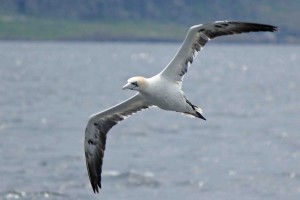 In the beginning, it was Largs Yacht Club that seemed to be Scotland’s most appealing place; current weather- wet and windy. The next couple of days were a mixture of motor-sailing in a calm or reefed main and jib, both with lashings of Scotch mist. However the quiet serenity of East Loch Tarbert was pure joy. Amongst its eclectic set of lovely old wooden boats reflected in dead pan water was Swn-Y-Mor, the old Welsh lifeboat, once of St Davids Pembrokeshire. Her name translates to Sound of the Sea, and is honourably justified for she has two wooden plaques fixed to her cabin. The first records the loss of one of her crew, washed overboard attending a stricken vessel in 1921. The other records her 84,000 mile, nine-year world circumnavigation between 1984 and 1993.
In the beginning, it was Largs Yacht Club that seemed to be Scotland’s most appealing place; current weather- wet and windy. The next couple of days were a mixture of motor-sailing in a calm or reefed main and jib, both with lashings of Scotch mist. However the quiet serenity of East Loch Tarbert was pure joy. Amongst its eclectic set of lovely old wooden boats reflected in dead pan water was Swn-Y-Mor, the old Welsh lifeboat, once of St Davids Pembrokeshire. Her name translates to Sound of the Sea, and is honourably justified for she has two wooden plaques fixed to her cabin. The first records the loss of one of her crew, washed overboard attending a stricken vessel in 1921. The other records her 84,000 mile, nine-year world circumnavigation between 1984 and 1993.
The forecast for the next two days was identical- east or south-east F3 or 4 increasing 5 for a time. Sea state slight, occasional rain, visibility moderate or good, occasionally very poor. It could have been worse, especially considering the deluge of rain falling over most of England and Wales with flood warnings scattered across the land. We explored Upper Loch Fyne, picking up a mooring for a lunch stop in the shadow of an ivy-clad ruined tower, before re-tracing our track to fetch up at Otter Ferry and the excellent Oystercatcher Inn.
All that was visible the following morning was grey. The sky, the sea and the rain in between. Yet it was perfectly calm, giving a strangely comforting view of a mono-chromed world. A light south-easterly ensured a series of long tacks back and fore across the loch. In between, we were busy watching gannets majestically sky-diving into the sea to feed in a high speed-vertical dive from two hundred feet, like a stone from a catapult. By the time we moored at Lochranza the grey had been replaced by idyllic sunshine and blue sky. It is a magical harbour with the ruins of a 13th Century fortified house still dominating the upper reaches. A family of deer grazed on the exposed sea-weed in the harbour, searching out a sea food supper. We ate in the only pub in town, the Lochranza Hotel and afterwards sat in HF’s cockpit with a glass in hand, watching the last reflections of daylight fall into deepening twilight.
After a better than expected cruise along Aran’s east coast, we spent the next night moored off Lamlash, behind the Buddhist retreat of Holy Isle. The continuing easterly set up a petulant little swell which gave us a rocky night, listening to the moan of the wind through taut rigging and the anchor rattling it it’s cradle on the foredeck.
Abandoning plans for a circumnavigation of Aran, HF set off to the north and tacked a mile or two out to sea. From there we watched rain clouds gathering over the island giving the hills around Goat Fell a dark and brooding feel as they slipped by to port. We sailed along a crease in Bute Sound, steel grey seas to starboard and deep bottle green specked with whitecaps stretching to the ominous shoreline on the other side. A ring of dark water my precious!
Ducking inside the island, we passed though Inchmarnock Sound and eased into the Kyles of Bute, scattering a small crowd of gannets resting on the water. Here at last, we got a few close-up photos of these beautiful birds, once known to sailors of old as the sea goose. Our last night was spent at Colintraive Point and a splendid meal at the eponymous pub where our haggis-hatted crewman George, regaled the entire bar with his impish sense of humour. As ever though, it is the combined consent of the crew, be they friends or strangers, that determines the worthiness of any cruise. And ours was a simply a privilege.
